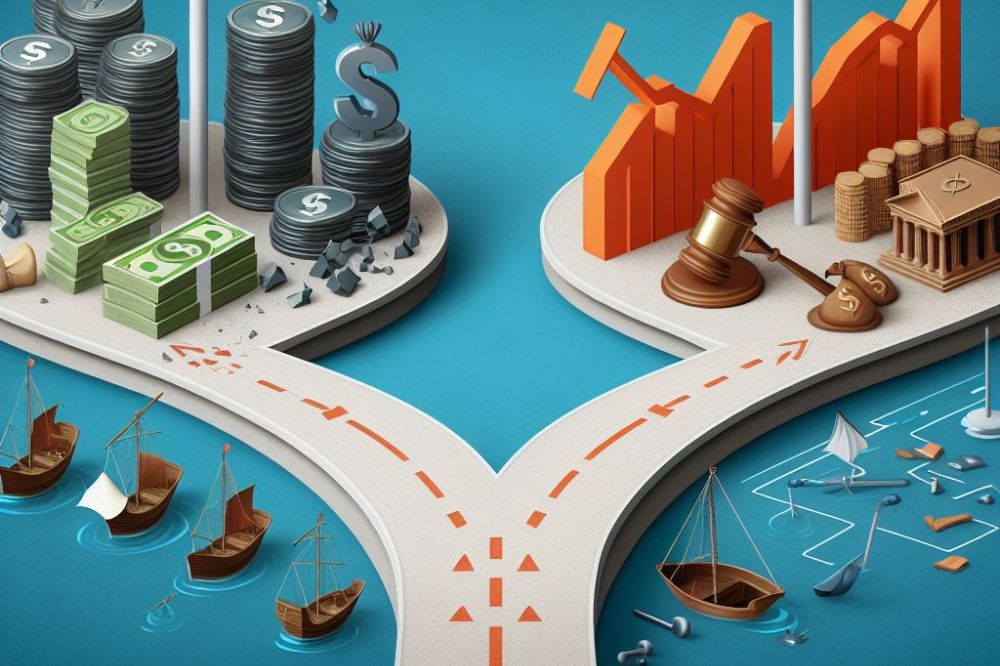Understanding the difference between insolvency and bankruptcy is crucial for financial literacy. While both involve financial distress, debt solutions differ in legal implications and processes. Insolvency refers to a financial state where liabilities exceed assets, impacting an individual or business’s ability to meet financial obligations. On the other hand, bankruptcy is a legal process that provides relief to debtors unable to repay their debts, often resulting in asset liquidation or restructuring under court supervision. Recognizing these distinctions can help individuals, firms, and businesses navigate challenging financial situations with clarity and informed decision-making.
Key Takeaways
- Know the Difference: Understanding that insolvency refers to the financial state of being unable to pay debts when they are due, while bankruptcy is a legal process that helps individuals or businesses get relief from debt.
- Early Recognition: Recognize the signs of insolvency early on, such as constant cash flow issues or mounting debts, to address financial challenges proactively.
- Consider Alternatives: Before opting for bankruptcy, explore alternatives like debt restructuring, negotiation with creditors, or seeking financial counseling to manage and alleviate debt burdens.
- Protect Your Credit: Be aware that both insolvency and bankruptcy can impact your credit rating negatively, but taking steps to manage debt responsibly post-bankruptcy can help rebuild your credit over time.
- Seek Professional Guidance: When facing insolvency or considering bankruptcy as a corporate debtor, consult with financial advisors, credit counselors, or bankruptcy attorneys to navigate the complex financial decisions effectively.
- Educate Yourself: Take advantage of additional resources like financial literacy programs, support groups, or online tools to enhance your understanding of insolvency, bankruptcy, and debt management strategies.
Understanding Insolvency
Definition
Insolvency refers to a financial state where an individual or entity, including a company or corporate debtor, cannot meet financial obligations. Bankruptcy is a legal process that follows insolvency, involving court proceedings and debt restructuring. Understanding the differences in legal terms between insolvency and bankruptcy is crucial. Insolvency signifies financial distress, while bankruptcy, which means a formal declaration of inability to repay debts, involves a chapter declaration.
Causes
Financial Mismanagement
Financial mismanagement plays a significant role in leading individuals or businesses towards insolvency or bankruptcy. Poor budgeting, overspending, and lack of financial planning are common culprits. Examples include extravagant spending beyond means, failure to track expenses, and neglecting savings for emergencies.
Economic Downturn
Economic downturns can exacerbate financial struggles, contributing to insolvency and bankruptcy rates. During economic recessions, businesses may experience reduced revenue streams and increased operating costs. This dynamic can lead to cash flow problems and eventual insolvency. Statistics show a direct correlation between economic downturns and spikes in bankruptcy filings.
Signs
Recognizing key signs of potential insolvency or bankruptcy, especially for a corporate debtor, is essential for proactive financial management. Individuals or businesses should watch for warning signals such as mounting debts, consistent cash flow issues, and frequent creditor calls. Early identification of these signs enables timely intervention to prevent the escalation of financial distress.
Exploring Bankruptcy
Legal Process
Individuals or businesses, including corporate debtors, facing insolvency or bankruptcy must navigate complex legal processes. In insolvency, negotiations with creditors occur to restructure debts. Bankruptcy, for a corporate debtor, involves filing a petition in court, triggering an automatic stay on debt collection.
Legal professionals play a crucial role in guiding individuals, businesses, and corporate debtors through the insolvency and bankruptcy processes. Courts oversee bankruptcy cases, ensuring fair treatment of creditors and debtors. Steps include submitting financial information, attending meetings, and following court orders.
Types
Chapter 7
Chapter 7 bankruptcy involves liquidating assets to repay debts. Qualification depends on passing a means test based on income and expenses. Benefits include quick discharge of debts, but drawbacks involve potential loss of property.
Chapter 13
Chapter 13 bankruptcy allows individuals to restructure debts through a repayment plan. Qualification requires a reliable income source to meet payment obligations. Benefits include keeping assets while repaying debts over time. Drawbacks involve a longer process and strict adherence to the repayment plan.
Consequences
Insolvency and bankruptcy have significant consequences for both individuals and businesses. Filing for bankruptcy can lead to the discharge of certain debts but may result in the loss of assets. Long-term effects include challenges in obtaining credit or loans due to damaged credit scores.
The impact of insolvency and bankruptcy on financial futures is profound, affecting one’s ability to secure favorable interest rates or access financial opportunities. It is essential to consider the lasting repercussions before deciding to file for bankruptcy.
Insolvency vs Bankruptcy
Conceptual Differences
Insolvency and bankruptcy are distinct concepts. Insolvency signifies a financial state where an individual or entity cannot meet financial obligations. On the other hand, bankruptcy is a legal process initiated to resolve insolvency issues. Understanding these variances is vital for effective financial management.
Insolvency primarily denotes financial distress, indicating the inability to repay debts as they fall due. In contrast, bankruptcy is a legal declaration of one’s inability to pay debts, leading to potential asset liquidation. Recognizing these nuances aids in navigating financial challenges efficiently.
Comprehending the differences between insolvency and bankruptcy is essential for making informed decisions regarding debt management and financial stability. While insolvency reflects a financial condition, bankruptcy involves a legal procedure with specific implications on assets and liabilities.

Legal Implications
The legal implications of insolvency and bankruptcy differ significantly. Being insolvent implies facing financial difficulties without involving any formal legal proceedings. In contrast, declaring bankruptcy involves a legal process overseen by the court system to address outstanding debts.
Legal implications vary based on whether an individual or business is insolvent or has filed for bankruptcy protection. Insolvency may lead to negotiations with creditors to restructure debts, while bankruptcy can result in asset liquidation or repayment plans sanctioned by the court.
Seeking professional legal advice is crucial when dealing with insolvency or contemplating bankruptcy proceedings. Legal experts can provide guidance on the best course of action based on individual circumstances and help navigate complex legal processes effectively.
Leading Causes of Insolvency
Poor Cash Flow
Poor cash flow is a primary cause of insolvency, leading individuals or businesses to financial distress. Inadequate cash flow management often results in difficulty meeting financial obligations. This can ultimately trigger insolvency or bankruptcy proceedings. To avoid such situations, it is crucial to closely monitor cash inflows and outflows. Implementing efficient invoicing and payment collection systems can help improve cash flow stability.
Inadequate cash flow management not only affects day-to-day operations but also impacts long-term financial stability. A consistent lack of cash flow can hinder growth opportunities and lead to mounting debts. Individuals or businesses experiencing poor cash flow may struggle to cover essential expenses, risking insolvency. By maintaining a healthy reserve fund and budgeting effectively, one can mitigate the risks associated with poor cash flow and prevent insolvency.
- Monitor cash inflows and outflows regularly
- Implement efficient invoicing and payment collection systems
- Maintain a healthy reserve fund for emergencies
Excessive Debt
Accumulating excessive debt is another key factor that can push individuals or businesses towards insolvency or bankruptcy. High levels of debt can strain financial resources, making it challenging to meet repayment obligations. Unsustainable debt levels not only increase financial stress but also limit future borrowing capacity. Individuals or businesses burdened with excessive debt may find it difficult to invest in growth opportunities or navigate unexpected financial challenges.
Managing and reducing excessive debt is essential for avoiding insolvency or bankruptcy. Creating a detailed repayment plan and negotiating with creditors for favorable terms can help alleviate the burden of debt. Exploring debt consolidation options or seeking professional financial advice can provide valuable insights into effectively managing and reducing debt levels.
- Create a detailed repayment plan
- Negotiate with creditors for favorable terms
- Explore debt consolidation options
When Bankruptcy Is Preferable
Legal Protection
Legal protection differs significantly for insolvent individuals and bankrupt entities. Insolvent individuals may opt for informal arrangements to settle debts, lacking the legal safeguards of bankruptcy. In contrast, bankrupt entities benefit from automatic stays that halt creditor actions, providing a shield against lawsuits or collection attempts. Understanding these distinctions is crucial in navigating financial turmoil effectively.
Individuals and businesses facing insolvency or bankruptcy are granted specific rights and protections under the law. During insolvency, individuals can negotiate repayment plans with creditors but lack the formalized structure and court oversight available in bankruptcy proceedings. On the other hand, bankruptcy offers a structured process overseen by a trustee, ensuring fair treatment of all parties involved. Knowing these rights empowers individuals and businesses to make informed decisions during financial hardships.
Understanding legal protections during financial distress is paramount for individuals and businesses alike. In insolvency, individuals may face aggressive collection efforts without legal intervention, leading to potential asset seizures or wage garnishments. Conversely, bankruptcy shields assets from seizure through the automatic stay, providing breathing room to reorganize finances methodically. This knowledge equips individuals and businesses to navigate challenging financial circumstances with confidence.

Debt Discharge
Debt discharge in bankruptcy refers to the elimination of certain debts through a court-approved process. Bankruptcy allows for the discharge of unsecured debts such as credit card balances, medical bills, and personal loans, offering a fresh start for debtors burdened by overwhelming financial obligations. However, certain debts like student loans, tax debts, and child support payments are typically not dischargeable through bankruptcy.
The implications of debt discharge on financial obligations are profound for individuals seeking relief from crippling debt burdens. Upon successful completion of a bankruptcy case, discharged debts are no longer enforceable by creditors, freeing debtors from past liabilities. This clean slate enables individuals to rebuild their financial standing without being weighed down by unsustainable debt levels.
Alternatives to Bankruptcy
Consumer Proposal
A consumer proposal is a formal agreement between an individual and their creditors to settle debts. It allows the debtor to repay a portion of what is owed over an extended period, typically up to five years. Unlike bankruptcy, a consumer proposal does not involve surrendering assets like a house or car.
Consumer proposals differ from bankruptcy in that they offer more flexibility and control for the debtor. While bankruptcy may severely impact one’s credit score for several years, a consumer proposal allows individuals to maintain ownership of their assets while still addressing their debt.
Filing a consumer proposal involves working with a licensed insolvency trustee who helps create a viable repayment plan. This plan is then presented to creditors for approval. If the majority of creditors accept the proposal, all unsecured debts included in the agreement are settled, providing relief for the debtor.
Debt Management Plan
A debt management plan is a structured program designed to help individuals repay their debts in full through manageable monthly payments. It involves negotiating reduced interest rates and payment amounts with creditors to make repayment more feasible.
Debt management plans assist individuals in avoiding bankruptcy by providing a structured approach to debt repayment without resorting to legal proceedings. By consolidating multiple debts into one affordable monthly payment, individuals can regain control of their finances and avoid the long-term consequences of bankruptcy.
Creating an effective debt management plan involves assessing one’s financial situation, listing all debts, and developing a realistic budget. It’s crucial to prioritize high-interest debts and explore options for reducing interest rates or negotiating payment terms with creditors.
Impact on Credit Rating
Short-term Effects
Facing insolvency or bankruptcy negatively impacts an individual’s or business’s credit rating immediately. This can result in limited access to credit facilities and loans, hindering financial flexibility. Daily operations may suffer, with challenges in paying bills and meeting financial obligations. The stress of financial distress can affect decision-making and overall productivity.
Navigating the short-term effects of insolvency or bankruptcy involves prioritizing essential expenses, communicating openly with creditors, and seeking professional advice. It is crucial to assess the current financial situation accurately and make informed decisions to mitigate further damage to credit ratings.
Long-term Recovery
To achieve long-term financial recovery post-insolvency or bankruptcy, individuals and businesses must focus on rebuilding their creditworthiness gradually. Creating a sustainable financial plan is key to regaining stability and credibility in the eyes of lenders. This involves budgeting, saving, and establishing positive payment histories.
Successful long-term recovery often includes strategies such as debt restructuring, improving cash flow management, and investing in financial education. By demonstrating responsible financial behavior over time, individuals can rebuild their credit rating and regain access to credit facilities.
Achieving Permanent Debt Relief
Sustainable Practices
Implementing sustainable financial practices is crucial to avoid insolvency or bankruptcy. Budgeting effectively and saving money are key steps in maintaining financial stability. By tracking expenses and prioritizing needs over wants, individuals can build a strong financial foundation. Developing an emergency fund for unexpected expenses is also essential.
To prevent insolvency or bankruptcy, it’s vital to cultivate healthy financial habits. Creating a budget that outlines income and expenses helps individuals manage their finances effectively. Prioritizing saving a portion of income each month builds a safety net for future financial challenges. By avoiding unnecessary debt and living within one’s means, individuals can safeguard themselves against financial crises.
- Pros: Promotes financial discipline
- Cons: Requires commitment and consistency
Financial Planning
Financial planning plays a significant role in steering clear of insolvency or bankruptcy. By creating a comprehensive financial plan, individuals can set clear goals, track progress, and make informed decisions about their finances. Understanding cash flow, setting realistic objectives, and diversifying investments are key components of a solid financial plan.
Developing a sound financial planning strategy involves several steps. Begin by assessing current financial status, including income, expenses, assets, and liabilities. Set specific short-term and long-term goals to work towards achieving financial stability. Regularly review and adjust the financial plan as needed to adapt to changing circumstances.
- Assess current financial status
- Set specific short-term and long-term goals
- Diversify investments for risk management
Additional Resources
Professional Advice
Seeking professional advice is crucial when dealing with insolvency or bankruptcy to make informed decisions. Financial advisors, lawyers, and insolvency experts can provide valuable insights into managing financial challenges effectively. It’s essential to consult these experts to understand the implications of insolvency on assets and liabilities.
When facing financial difficulties, it’s advisable to consult financial advisors who can offer strategies for improving financial health and preventing future crises. lawyers specialized in bankruptcy law can provide legal guidance on navigating complex legal procedures involved in insolvency cases.
To find reputable professionals, consider seeking recommendations from trusted sources such as friends, family, or professional networks. Conduct thorough research to ensure the expertise and credibility of the professionals you choose to work with during challenging financial times.
Legal Support
Legal support plays a vital role in safeguarding rights and interests throughout insolvency or bankruptcy proceedings. Legal professionals possess the expertise to interpret complex legalities and ensure compliance with relevant laws and regulations.
During insolvency proceedings, legal support is essential for representing individuals or businesses in negotiations with creditors and court appearances. Lawyers specializing in bankruptcy law can provide strategic advice on protecting assets and resolving debts efficiently.
Final Remarks
You now grasp the disparities between insolvency and bankruptcy, recognizing their implications on your financial well-being. Understanding these distinctions equips you to make informed decisions when facing financial challenges. By exploring the causes, consequences, and available options, you empower yourself to navigate tough situations wisely.
Take charge of your financial future by applying this knowledge. Seek professional advice if needed and explore alternatives before opting for bankruptcy. Remember, financial literacy is a powerful tool in securing your economic stability. Stay informed, stay proactive, and pave the way for a brighter financial tomorrow.
Frequently Asked Questions
What is the difference between insolvency and bankruptcy?
Insolvency refers to a financial state where you are unable to pay debts, while bankruptcy is a legal process declaring that one cannot repay debts. Insolvency is a financial condition, while bankruptcy is a legal status.
When is bankruptcy preferable over dealing with insolvency?
Bankruptcy may be preferable when you have explored all other debt relief options without success. It provides a structured process for managing overwhelming debt and can offer a fresh start financially by discharging certain debts.
What are some common causes of insolvency?
Common causes of insolvency include excessive debt, poor cash flow management, economic downturns, unexpected expenses like medical bills or job loss, and high-interest rates leading to unmanageable debt levels.
How does bankruptcy impact one’s credit rating?
Bankruptcy can significantly impact your credit rating, causing it to drop substantially. However, it also offers an opportunity for a fresh financial start by eliminating or restructuring debts, which can eventually help in rebuilding credit over time.
Are there alternatives to filing for bankruptcy?
Yes, there are alternatives to bankruptcy such as debt consolidation, negotiation with creditors for lower payments or interest rates, credit counseling services, and creating a repayment plan to manage debts effectively without resorting to bankruptcy.




